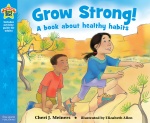By Cheri J. Meiners, author of the Learning to Get Along® and Being the Best Me! series
 Children, though young and small, have within them everything they need to grow to adulthood. As children learn to love and appreciate their amazing bodies, they will likely find motivation to develop healthy habits for building and maintaining wellness. Some of these key habits are eating healthy foods, especially those from plants; drinking clean water; moving and exercising in the fresh air and sunshine; and getting plenty of sleep. Establishing patterns of good eating, exercise, and sleep requires self-discipline, which will aid children in building strong muscles and bones, making friends, learning well, and feeling a greater sense of control over their lives.
Children, though young and small, have within them everything they need to grow to adulthood. As children learn to love and appreciate their amazing bodies, they will likely find motivation to develop healthy habits for building and maintaining wellness. Some of these key habits are eating healthy foods, especially those from plants; drinking clean water; moving and exercising in the fresh air and sunshine; and getting plenty of sleep. Establishing patterns of good eating, exercise, and sleep requires self-discipline, which will aid children in building strong muscles and bones, making friends, learning well, and feeling a greater sense of control over their lives.
Here are some important, common-sense principles that children can begin to incorporate into their routines now. At the end of this post, there is an activity to do with kids to help reinforce these healthy concepts.
Healthy Eating
Establish regular mealtimes. Dinnertime is typically a great opportunity for the family to gather and bond through eating, relaxing, and talking together. Regular meals and snacks also help children learn to recognize their hunger signals to avoid overeating and the mood swings that can come with erratic eating patterns. You might choose to make healthy snacks easily accessible but limit snacking on junk food.
Establish regular mealtimes. Dinnertime is typically a great opportunity for the family to gather and bond through eating, relaxing, and talking together. Regular meals and snacks also help children learn to recognize their hunger signals to avoid overeating and the mood swings that can come with erratic eating patterns. You might choose to make healthy snacks easily accessible but limit snacking on junk food.
Choose healthy foods. Encourage children to include a fruit or vegetable with every meal and snack for a daily average of five servings of fruits and vegetables. Also, serve plenty of satiating foods like whole, unprocessed grains (rice, oats, and pasta) and non-starchy vegetables high in fiber (greens, squash, broccoli). Beans and lentils (legumes) are another healthy food group that is high in protein and fiber.
The Physicians Committee of Responsible Medicine, using recent scientific studies, recommends that lunch and dinner plates consist of these four food groups: fruit, vegetables, whole grains, and legumes. The current 2015 U.S. Dietary Guidelines say, “On average, current dietary patterns are too low in vegetables, fruit, whole grains . . . and too high in refined grains, saturated fat [meat, dairy, eggs], added sugars, and sodium.” The foods, then, that we are encouraged to limit or avoid are those high in saturated fat and cholesterol (which are found almost exclusively in meat, eggs, and dairy), as well as foods containing salt and added sugars.
Encourage your fussy eater. Try to serve a variety of foods, including those that you know your child will enjoy. Don’t force a child to eat, and don’t offer other choices if a food is refused. Give a child several opportunities to try a new food because it often takes several attempts for a palate to adjust to something new. Act neutrally when your child doesn’t eat a food, but give praise for trying something new. Serve children small portions, and let them ask for more if they are still hungry. Don’t require them to finish everything on a plate. Find ways other than food to convey praise and rewards. Eating habits are developed over time and through example and consistency.
Exercise and Movement
Spend time with your child outdoors. Not only is exercise invigorating, but fresh air and sunshine are also important physically. Exposure to sunlight helps the body produce important chemicals and vitamins like nitric oxide and vitamin D. Sunshine and being outdoors are also mood enhancers, especially when your child also spends time with you. Children need about 60 minutes of physical activity every day. Consider family activities such as biking, hiking, skating, or visiting a park, zoo, or pool. Household chores, such as washing a car, weeding a garden, housecleaning, and yard work, are also ways to get physical activity while accomplishing a task together. You might also consider gifts that emphasize physical activity or participating in community sports, where feasible.
Spend time with your child outdoors. Not only is exercise invigorating, but fresh air and sunshine are also important physically. Exposure to sunlight helps the body produce important chemicals and vitamins like nitric oxide and vitamin D. Sunshine and being outdoors are also mood enhancers, especially when your child also spends time with you. Children need about 60 minutes of physical activity every day. Consider family activities such as biking, hiking, skating, or visiting a park, zoo, or pool. Household chores, such as washing a car, weeding a garden, housecleaning, and yard work, are also ways to get physical activity while accomplishing a task together. You might also consider gifts that emphasize physical activity or participating in community sports, where feasible.
A Good Night’s Sleep
Children need more sleep than adults. Ten to twelve hours is the average sleep requirement for children ages four to eight. Plan an appropriate bedtime together based on when your child needs to get up. Help your child develop a comforting nightly ritual that might include brushing teeth, putting on pajamas, reading a story together, and reviewing the highlights of the day. Bedtime may be when your child is willing to talk and share with you if the process isn’t too rushed. Tuck your child into bed, perhaps with a favorite toy, book, or nightlight. Children will settle in and fall asleep more quickly if they feel safe and secure. If a child gets up after that, limit attention and conversation so it isn’t too rewarding (or too punishing) for them to be up after their bedtime.
Children need more sleep than adults. Ten to twelve hours is the average sleep requirement for children ages four to eight. Plan an appropriate bedtime together based on when your child needs to get up. Help your child develop a comforting nightly ritual that might include brushing teeth, putting on pajamas, reading a story together, and reviewing the highlights of the day. Bedtime may be when your child is willing to talk and share with you if the process isn’t too rushed. Tuck your child into bed, perhaps with a favorite toy, book, or nightlight. Children will settle in and fall asleep more quickly if they feel safe and secure. If a child gets up after that, limit attention and conversation so it isn’t too rewarding (or too punishing) for them to be up after their bedtime.
A Balanced Child
Proper nourishment, movement, and sleep can give children the energy they need to accomplish what they want to do. Their confidence will also increase as they become more aware of their own unique bodies and abilities. Besides a growing body, children have growing minds, consciences, and personalities. Each of these aspects can be enhanced by a healthy, disciplined body. All children, no matter their physical strengths or limitations, can benefit from healthy physical, mental, emotional, and social habits. You play a key role in helping your child grow strong in every way!
Proper nourishment, movement, and sleep can give children the energy they need to accomplish what they want to do. Their confidence will also increase as they become more aware of their own unique bodies and abilities. Besides a growing body, children have growing minds, consciences, and personalities. Each of these aspects can be enhanced by a healthy, disciplined body. All children, no matter their physical strengths or limitations, can benefit from healthy physical, mental, emotional, and social habits. You play a key role in helping your child grow strong in every way!
Consider the following activity to help your children build appreciation for their bodies.
“Our Healthy Habits” Poster
Materials: copy paper, construction paper, and poster paper for each child; crayons and markers; magazines; glue sticks; scissors
Materials: copy paper, construction paper, and poster paper for each child; crayons and markers; magazines; glue sticks; scissors
Directions: Help children learn about healthy habits by connecting each habit to an element of nature: earth, water, sun, air, and moon. First ask children to draw pictures of the five elements on construction paper and cut them out. Print a copy of the sentences below for each child and have them cut out each sentence onto a separate strip. Then have children attach the sentences and elements to their poster. Lastly, have them draw or attach pictures of children eating, sleeping, and playing.
Variation: Put children into groups of five and let each child in the group be responsible for one habit and element.
I eat plants that come from the EARTH.
I drink pure WATER.
I feel warm and happy when I play in the SUN.
I like to breathe fresh AIR and run like the wind.
The MOON ‘keeps a light on’ while I sleep.
I drink pure WATER.
I feel warm and happy when I play in the SUN.
I like to breathe fresh AIR and run like the wind.
The MOON ‘keeps a light on’ while I sleep.
 Cheri J. Meiners, M.Ed., has her master’s degree in elementary education and gifted education. A former first-grade teacher, she has taught education classes at Utah State University and has supervised student teachers. Cheri and her husband David have six children and enjoy the company of their lively grandchildren. They live in Laurel, Maryland.
Cheri J. Meiners, M.Ed., has her master’s degree in elementary education and gifted education. A former first-grade teacher, she has taught education classes at Utah State University and has supervised student teachers. Cheri and her husband David have six children and enjoy the company of their lively grandchildren. They live in Laurel, Maryland.
Free Spirit books by Cheri J. Meiners:




